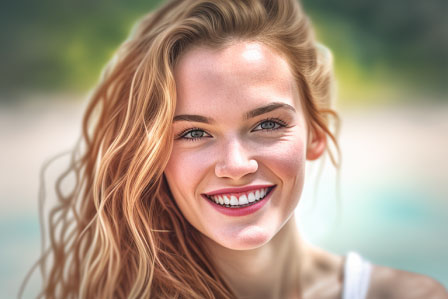Although sunscreens are important throughout the year, they are especially important during the summer months. The sun is much stronger during the summer months than it is at other times of the year. For this reason, skin that is unprotected will get injured or burned much more quickly during the summer months. To encourage the use of sunscreens this summer, we are providing all of our newsletter subscribers with the following information on sunscreens.
How high of an SPF number do I need?
SPF stands for Sun Protection Factor. Sunscreens are rated by their SPF. The SPF can range from as low as 2 to over 50. The SPF rating is calculated by comparing the amount of time needed to produce redness on sunscreen protected skin to the amount of time needed to produce redness on unprotected skin. Skin treated with an SPF 15 sunscreen would take 15 times longer to become red than it would take if no sunscreen had been used. By the way, the SPF rating applies only to UVB light. At this time, there is no FDA approved rating system that measures UVA protection.
According to the American Academy of Dermatology, SPF 15 is the minimum SPF that should be used. An SPF 15 sunscreen will absorb 93% of the Ultraviolet B (UVB) rays, while an SPF 30 sunscreen will absorb 97%. As you can see, SPF 30 is definitely not twice as effective as SPF 15. Since the additional absorption of ultraviolet light is relatively small, other factors become more important in preventing sun damage than the SPF number. These factors include the time of day during which the sun exposure occurs, how thoroughly the sunscreen is applied, whether or not the sunscreen is reapplied, and whether sunglasses, hats, and other protective clothing are worn.
In our practice, we modify this recommendation for patients who are extremely sun sensitive or who have a history of skin cancer. We recommend that these patients use a sunscreen of SPF 25-30. In addition, we recommend that these patients consider making life-style modifications that limit their sun exposure.
What should I look for on a bottle of sunscreen?
There are many different types of sunscreens, including ointments, creams, gels, lotions, sprays, and wax sticks. The type of sunscreen used is a matter of personal choice. In general, men may prefer an alcohol-based gel or spray sunscreen because they are lighter than creams and heavy lotions. Women often prefer a moisturizer combined with a sunscreen or a product that blends well with their makeup. Oil-free sunscreens will feel less greasy.
Regardless of which types of sunscreens are used, they should have the following characteristics. They should be water resistant, so they are not easily removed by sweating or swimming and they should also be broad-spectrum, protecting against UVA and UVB light. UVB light causes sunburns and is the primary cause of skin cancer. UVA light penetrates deeper into the skin and also contributes to sunburns and skin cancer. It also is a major factor in causing sun-damaged skin.
Should the SPF number differ from face to body?
In general, it is not necessary to use a different sunscreen on different parts of the body. As long as the SPF of the sunscreen is at least 15 and the sunscreen protects against UVA and UVB radiation, one sunscreen can be used over the entire body (except for the lips, where you need a lip balm). However, if a person has a personal preference for one type of sunscreen product on their face and a different type of sunscreen product on their body, that is fine, so long as each product has an SPF of 15 or higher. For example, some people like to use a cream on their face and a lotion or spray on their body.
Is there a way to get a healthy tan on my body?
Remember, a suntan is the skin’s response to an injury. Tanning occurs when the sun’s ultraviolet rays penetrate into the skin’s deeper layers, causing the skin to produce more melanin as a response to the injury. The purpose of the sunscreen is to prevent the skin injury that leads to the tan. It does not make any sense to protect the face with an effective sunscreen and use a sunscreen with a lower SPF on the body to promote a light body tan. There is no such thing as a healthy tan.
What ingredients should you look for?
Every sunscreen of at least SPF 15 protects well against UVB light, since SPF is based on UVB protection. Commonly used ingredients that protect against UVB are cinnamates, salicylates, and padimate. PABA, which used to be used extensively for UVB protection, is being used much less frequently today due to a relatively higher incidence of sensitivity and allergic reactions.
It is also important to check that the sunscreen also contains ingredients that extend the sun protection beyond the UVB range into the UVA range. Ingredients that provide broad-spectrum UVA protection include benzophenones, oxybenzone, sulisobenzone, titanium dioxide, zinc oxide, and avobenzone (Parsol 1789).
We especially like sunscreens that contain zinc oxide and titanium dioxide. These are physical sunscreens that work by preventing the sunlight from reaching the skin. They are inert compounds that have unparalleled safety, have a negligible rate of allergic reactions, and provide both UVA and UVB protection.
The other types of substances found in sunscreens, such as the cinnamates, salicylates, and benzophenones are chemical sunscreens. They act by absorbing the light and have a higher rate of allergic reactions. If a person finds that he or she is sensitive to one particular sunscreen, it is probably due to one of the chemical sunscreens found in the product. In this case, try switching to another sunscreen with a different formulation.
If you are olive skinned or dark skinned, are your sunscreen needs vastly different from that of a fair-skinned woman?
No. A fair-skinned woman will be more sun sensitive and burn more quickly than an olive skinned woman. However, regardless of skin type, the American Academy of Dermatology recommends that a broad-spectrum sunscreen that protects against UVA and UVB light with an SPF of at least 15 be used on a year-round basis on any day that you will be in the sun for 20 minutes or longer. This applies even if the weather is cloudy outside.
How should I apply sunscreen and how often should I reapply?
Sunscreens should be applied to dry skin 20-30 minutes before going outdoors so that the sunscreen absorbs into the skin prior to the sun exposure. When applying sunscreen, pay particular attention to the face, ears, hands, and arms. Make sure you use enough sunscreen. One ounce, which is enough to fill a shot glass, is considered to be the amount needed to cover the exposed areas of the body properly. In general, people often use an insufficient amount of sunscreen, and this is one of the most common errors people make in using sunscreen.
Sunscreens should be reapplied every two hours or after swimming or perspiring heavily. Even water resistant sunscreens may lose their effectiveness after 80 minutes or so in the water. Sunscreen can also be rubbed off, so if you towel dry, reapply a waterproof sunscreen after drying off.
What are the most often neglected parts of the body?
On the upper body, the most commonly missed areas are the ears, lips, and neck so pay particular attention to these areas and use a lip balm with at least SPF 15 on the lips. On the rest of the body, the most common errors are either neglecting to apply the sunscreen in the first place or not using enough. Be careful to cover all of the exposed areas completely.
Are there any advantages to sunscreen sprays?
Sunscreen sprays may be easier to apply. If you use them, make sure that all of the skin is sprayed evenly and that you don’t miss a spot. If you miss a spot, it will burn.
Is there anything new in sunscreens?
Recently, tinted and glitter sunscreens have come on the market. They do not work better, but they provide a new look that some people like. Some sunscreens are now including antioxidants such as Vitamin C, Vitamin E, and green tea in their formulation. They are being included because they are said to protect the skin against free radical injury.
Besides sunscreen, what else can I do to protect myself from the sun?
Try to avoid being in the sun between 10:00 AM and 4:00 PM when the sun’s rays are the strongest. Seek shade whenever possible. Wear protective clothing when possible, including a wide-brimmed hat, sunglasses that protect against UVA and UVB, and long-sleeved shirts and pants. An easy way to test for the amount of sun protection in an article of clothing is to hold it up to a window and see how much light passes through the fabric. If a lot of light passes through, the clothing will not provide adequate sun protection, and a more opaque fabric should be worn.
How do self-tanners work and will the tan provide sun protection?
Most self-tanners contain dihydroxyacetone as the active ingredient. This chemical is a colorless sugar that reacts with the proteins located in the skin cells in the top layer of the skin. This interaction results in a color change and produces the “tan.” The “tan” only provides the equivalent of SPF 4 protection. Therefore, the “tan” will not provide sufficient sun protection, and the use of a sunscreen is still necessary.




